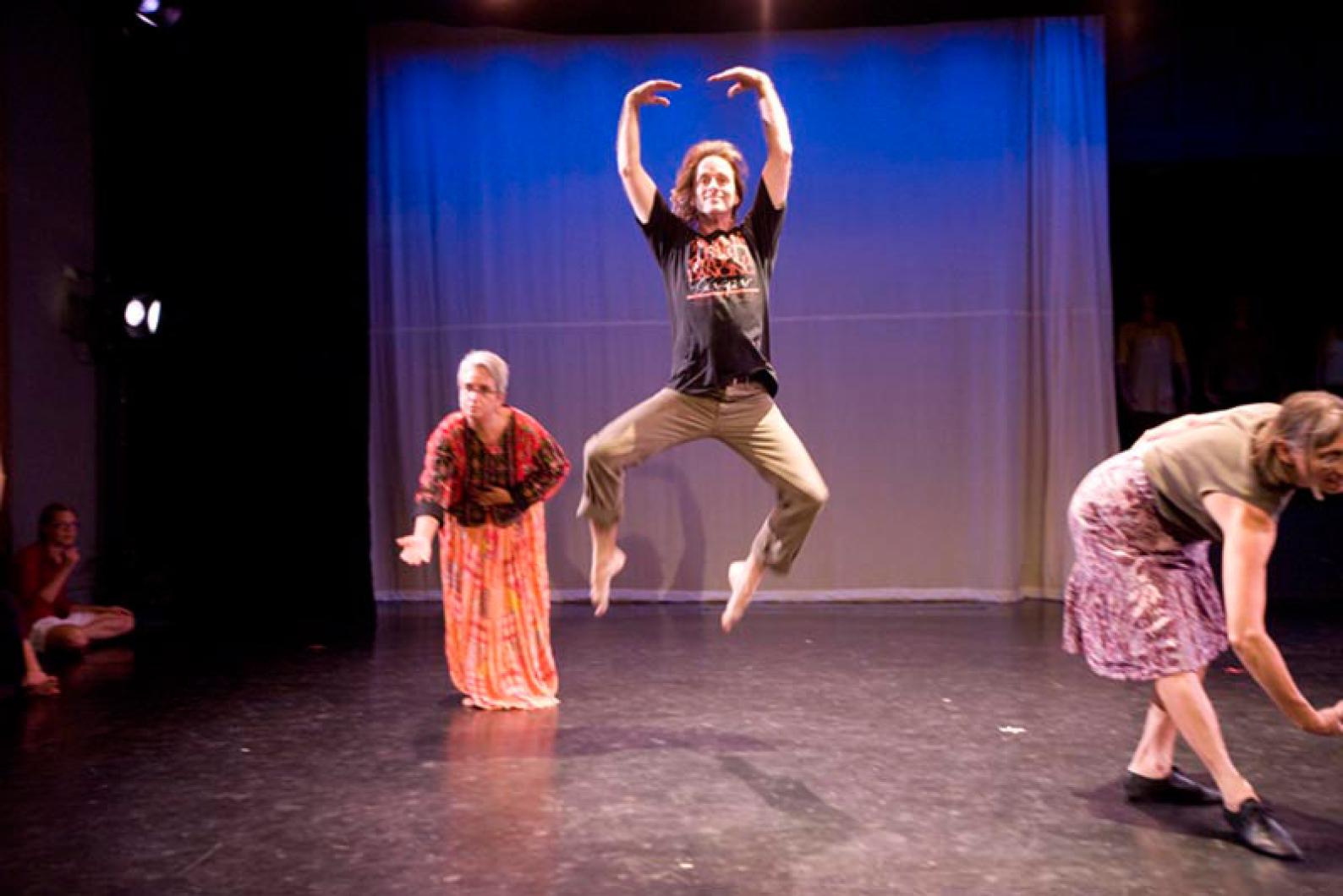Whether consuming or creating, Vineyarders are known for their enjoyment of the arts. On one side, the Island has a lot of galleries, artisans’ festivals and professional performances; on the other, there are classes and quality amateur opportunities for theatre, dance, music and fine arts. But it’s not common for the vocational and avocational processes to intertwine. Over the past two weeks at The Yard, choreographer Sarah Wilbur has masterminded just such an intertwining.
Ms. Wilbur is choreographing The Greatest Dance on Earth (Excerpts), a piece that will be performed by a mix of The Yard’s professional company dancers and non-professionals from the Island community. Within this latter group, which has an age range of 9 to 74, there is an impressive amount of talent. And — under Sarah’s gregarious, generous mentoring — there’s also an impressive amount of community.
The goal of the piece from the start, says Ms. Wilbur, was to make use of all the elements that the participants themselves brought to the piece. Anyone and everyone was welcome to participate, regardless of their experience. While she had a basic starting premise, the piece unfurled from her choreographic imagination as she became aware of what she had to work with — which turned out to be a motley compilation of folk dancing, waltzing, accordion playing, singing, belly dancing, magic tricks, visual and verbal comedy, modern dance, a send-up of ballet that Sarah herself calls “mincing and prancing,” and some other things easier seen than described.
Somehow, Sarah Wilbur has taken this entertaining hodgepodge and magically transformed it into The Greatest Dance on Earth (Excerpts), as put on by a ragtag collection of gypsy performers who love, among other things, arguments and things that spin around.
I was able to watch her create this transformation because I was a non-dancer (and I do mean a non-dancer) who decided to participate. I did so mostly because the idea of dancing in front of an audience terrified me, and I’m one of those kooks who makes myself attempt things I’m scared of, just on principle. Although I am still not a tower of confidence, it’s amazing to me how comfortable I feel about my discomfort — Sarah has created an environment in which there is no judgment. This gives a special spirit to the piece that in turn encourages the finest efforts of all involved. In a different setting, I’d be a different dancer — a far worse one.
The Greatest Dance was put together in an amazing ad-hoc manner over a two-week period. There were only two “mandatory” rehearsals (neither of which actually had the complete cast), and then more than a dozen smaller rehearsals to work out pieces-within-the-piece. Out of a cast of about 30, people showed up when they could and the choreographer worked around their schedules, with never more than two hours of rehearsal at a time per day. This could easily have led to chaos, disgruntlement, frustration or confusion, but Sarah kept the energy and the spirit of the process cheerful and bouncy. “I love you no matter what” — uttered as a single word — is one of her many mantras; her self-deprecating humor and generous energy consistently kept everybody positive. If she was expecting people who couldn’t make it that day (a not-uncommon occurrence with a cast made up of many people with important daily priorities, especially students and mothers), those present would work through the section anyhow. When their fellow dancers were able to make it to rehearsal, everyone was so dedicated about learning, or helping to learn, that an entire stage of performers got up to speed unbelievably fast. Not because they were worried what would happen if they didn’t, but because they knew it would be so much fun as soon as they did.
I arrived near the end of one rehearsal at which Sarah had been teaching a core group of dancers a celebratory, demonically-speedy folk-dance. Because that dance is the finale, it would eventually include all of us. I watched the finessed blur of bodies leaping and spinning across the stage and thought, “How the heck is she going to work the rest of us into that?” Here’s how: two teenage girls grabbed another newly-arrived dancer and myself, and showed us what to do when. On other parts of the stage, other dancers were doing the same thing with other newcomers. And the next time they went through the dance — i.e., the first time we went through the dance — hey presto! There it was, surprisingly polished, and as painless to learn as it was impressive to look at.
Speaking as a non-dancer, I have to say that half the time (or more) I don’t quite understand exactly what I’m doing, but I know how, when and where to do it, and if I were to screw up, there are more than two dozen fellow Islanders whom I absolutely trust to help me out — most of whom I’d never met until two weeks ago. I have no idea what most of my fellow dancers do when they’re not being my fellow dancers, and in a few weeks I’ll probably have forgotten everybody’s names, but that sense of trust, of shared experience and fun — that sense of community — will not end when this project does; it will remain, however subtly, when I encounter one of them at the grocery store, the beach, a town meeting or simply passing on the sidewalk. We will always have danced together. Sarah Wilbur has truly added a whole new layer of meaning to William Butler Yeats’ wonderful line: How can we tell the dancer from the dance?
The Greatest Dance on Earth (Excerpts) will be performed Friday through Sunday at 8 p.m. with a free family matinee Saturday at 4 p.m. To reserve seats at the matinee or tickets to the other shows, call 508-645-9662.






Comments
Comment policy »